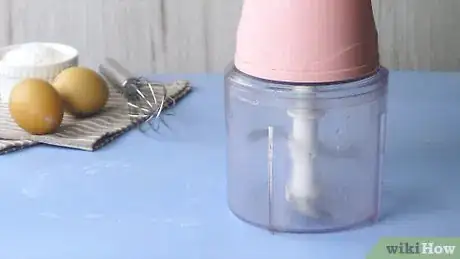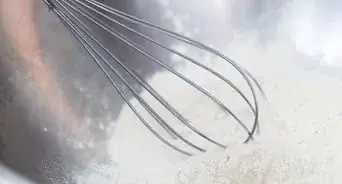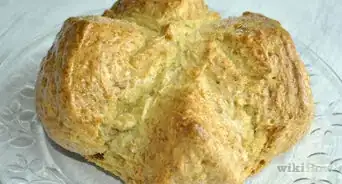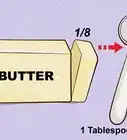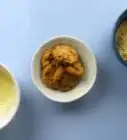This article was co-authored by wikiHow Staff. Our trained team of editors and researchers validate articles for accuracy and comprehensiveness. wikiHow's Content Management Team carefully monitors the work from our editorial staff to ensure that each article is backed by trusted research and meets our high quality standards.
There are 8 references cited in this article, which can be found at the bottom of the page.
The wikiHow Video Team also followed the article's instructions and verified that they work.
This article has been viewed 635,633 times.
Learn more...
Your cookies are nearly ready to ice, but your bag of powdered sugar has only a few sad specks of dust. Before you run to the store, check your pantry. You can make your own powdered sugar using just two ingredients: granulated sugar and cornstarch.
Ingredients
- 1 cup (200g) sugar
- 1½ tsp (7.5mL) cornstarch (recommended)
Steps
Blending Sugar into Powder
-
1Choose a blender or spice grinder. Keep in mind that sugar can scratch plastic or weak glass.[1] A high-powered blender is the fastest and most effective option, but any blender or spice grinder can do the job.
- Spice grinder or coffee grinders — which are essentially the same tool — pick up flavors from the ingredients they grind. Clean it thoroughly before using it for sugar.
- Many food processors will not work, possibly due to their large size.[2] You can try it with your machine, but you may end up with superfine sugar, or an uneven mix of superfine and powder.[3]
-
2Dry the equipment. Wipe the inside of your blender or spice grinder with a dry cloth. Any residual moisture from the last rinse will make the sugar stick to the sides.Advertisement
-
3Measure white granulated sugar. Only blend a maximum of 1 to 1½ cups (200–300g) in an average blender, or 2 cups (400g) in a high-powered one. Any more may block the blades from pulverizing all your sugar. For a spice grinder, just add as much as can comfortably fit, leaving a little space.
- For your first try, assume that 1 cup of granulated sugar will make 1 cup powdered sugar. A strong blender may be able to break it down almost to half volume, but it will be easy to grind more if you encounter this "problem" of perfectly powdered sugar.
-
4Add cornstarch (recommended). This step is mandatory for making glazes and icing, as it thickens the sugar into a proper paste. Even for other recipes, the starch will help prevent the powdered sugar from clumping due to moisture absorption. For each cup (200g) sugar, add 1½ teaspoon (7.5mL) cornstarch.
- This ratio is very close to the 3% mix used in commercial powdered sugar.[4] While most online powdered sugar instructions call for more cornstarch, the result may behave unpredictably in recipes, or have a poorer taste.
- Arrowroot powder is a good substitute for those avoiding corn products.
-
5Blend or grind until powdered. Blend or grind for 30–40 seconds, then take a look at the result. Repeat until powder flies up into the blender, and there are no visible crystals (usually 1–3 minutes total blending time). Leave the blender or spice grinder closed until the dust settles.
- Blending too long without pause may burn the sugar.
-
6Sift the sugar. Sift through a fine mesh to catch clumps. This is especially important if you are making an icing or glaze.
- If not using the sugar immediately, just sift right before using it in a recipe.
-
7Store powdered sugar in an airtight container. In theory, the sugar will last indefinitely. In practice, powdered sugar rapidly picks up moisture in the air. Keep the sealed container in a dry pantry or cupboard to slow the inevitable clumping. Store it away from sources of heat as well, which tend to increase humidity.[5]
- If the sugar clumps, sift it again before using it in a recipe.
Variations
-
1Blend with brown sugar instead. Although this is possible, the results will not be as fluffy or even as white sugar.[6] Brown sugar has extra moisture content, which can make it difficult to pulverize. Look for "free-flowing" brown sugar, or add an extra ½ tsp (2.5mL) cornstarch.[7]
- Do not use this semi-powdered sugar for icing, as it may turn out grainy and dark-tinted.
-
2Tint your sugar. Add color to powdered sugar by mixing in special "decorating dusts" available at baking supply stores. Avoid ordinary food coloring, which may dissolve the sugar.[8]
- If you use the powdered sugar for icing or glazes, just mix in ordinary food coloring to the final result.
-
3Mix in spices. If you decorate baked goods with your sugar or mix it into sweet drinks, add a little flair and flavor. Just toss in cinnamon or your favorite dessert spice into the jar, seal, and shake until blended. To get fancy, look for special powdered flavor extracts at kitchen supply stores.
Community Q&A
-
QuestionCan you use Splenda instead of sugar?
 Community AnswerYes. Splenda is a substitute sugar, but it does taste different than regular sugar. Follow the directions on the box for equivalents.
Community AnswerYes. Splenda is a substitute sugar, but it does taste different than regular sugar. Follow the directions on the box for equivalents. -
QuestionCan powdered sugar be turned into regular sugar?
 QamarTop AnswererNo, you cannot change powdered sugar into regular sugar.
QamarTop AnswererNo, you cannot change powdered sugar into regular sugar. -
QuestionCan I make a frosting without powder sugar?
 Community Answer
Community Answer
Warnings
- Powdered sugar and granulated sugar are not interchangeable in most recipes. The starch in the powdered sugar will absorb moisture in dough and batter, and the smaller grains are ineffective at creaming butter.[9] Going the other way, granulated sugar will add an unpleasant grainy texture to your icing.⧼thumbs_response⧽
References
- ↑ http://www.craftybaking.com/howto/sugar-superfine-make-your-own
- ↑ http://www.americastestkitchenfeed.com/super-quick-video-tips/2012/12/how-to-turn-granulated-sugar-into-superfine-and-confectioners-sugar-video/
- ↑ https://www.thekitchn.com/can-you-make-powdered-sugar-at-home-putting-tips-to-the-test-in-the-kitchn-213644
- ↑ http://www.sugar.org/all-about-sugar/types-of-sugar/
- ↑ http://www.doesitgobad.com/does-powdered-sugar-go-bad/
- ↑ http://cookieandkate.com/2014/how-to-make-powdered-sugar/
- ↑ http://www.sugar.org/all-about-sugar/types-of-sugar/
- ↑ http://www.craftybaking.com/howto/tint-or-tinting-sugar
- ↑ http://www.seriouseats.com/2014/05/the-serious-eats-guide-to-sugar-syrup-honey-natural-sweetners.html
About This Article
To make powdered sugar, start by measuring out 1 1/2 cups of sugar into your blender and adding 1 1/2 teaspoons of cornstarch. Next, blend the mixture for between 1-3 minutes or until the sugar has been blended into a powder. Finally, let the powdered sugar settle in the blender before sifting it through a fine sieve. For tips on how to store powdered sugar and how to make variations, read on!
